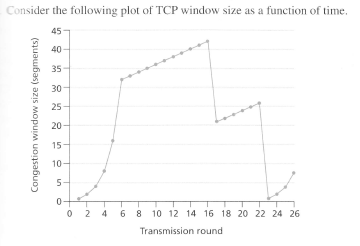

CNT 4704: Computer Communication Networks
Fall 2009
Homework 2
(assigned 10/06; due: 10/13, submitted via webcourse)
1. Chapter 3, problem 1.
Suppose Client A initiates a Telnet session with
Server S. At about the same time, Client B also initiates a Telnet
session with Server S. Provide possible source and destination port
numbers for
a). The segments sent from A to B.
b). The segments sent from B to S.
c). The segments sent from S to A.
d). The segments sent from S to B.
e). If A and B are different hosts, is it
possible that the source port number in the segments from A to S is the
same as that from B to S?
f). How about if they are the same host?
2. Chapter 3, problem 4.
a). Suppose you have the following 2 bytes: 00110100
and 01101001. What is the 1s complement of these 2 bytes?
b). Suppose you have the following 2 bytes: 11110101
and 00101001. What is the 1s complement of these 2 bytes?
c). For the bytes in part (a), give an example where
one bit is flipped in each of the 2 bytes and yet the 1s complement
doesn't change.
3. Chapter 3, problem 12.
Consider the rdt 3.0 protocol. Draw a diagram
showing that if the network connection between the sender and receiver
cna reorder messages (that is, that two messages propagating in the
medium between the sender and receiver can be reordered), then the
alternating-bit protocol will not work correctly (make sure you clearly
identify the sense in which it will not work correctly). Your diagram
should have the sender on the left and the receiver on the right, with
the time axis running down the page, showing data (D) and
acknowledgement (A) message exchange. Make sure you indicate the
sequence number associated with any data or acknowledgement segment.
4. Chapter 3, problem 22 (Problem 21 in 4th
edition).
Justify your answer even if
the answer is true. For statement (a), you should justify it by drawing
a
protocol running example.
Answer true or false to the following statements and
briefly justify your answer:
a). With the SR protocol, it is possible fo
rthe sender to receive an ACK for a packet that falls outside of its
current window.
b). With GBN, it is possible fo
rthe sender to receive an ACK for a packet that falls outside of its
current window.
c). The alternating-bit protocol is the same
as the SR protocol with a sender and receiver window size of 1.
d). The alternating-bit protocol
is the same as the GBN protocol with a sender and receiver window size
of 1.
5. Chapter 3, problem 24 (Problem 23 in 4th
edition).
For qustion (b), assume that the
network is perfect and there is no error or retransmissions.
Consider transferring an enormous file of L bytes
from Host A to Host B. Assume an MSS of 1,460 bytes.
a). What is the maximum value of L such that TCP
sequence numbers are not exhausted? Recall that the TCP sequence number
field has 4 bytes.
b). For the L you obtain in (a), find how long it
takes to transmit the file. Assume that a total of 66 bytes of
transport, netowrk and data-link header are added to each segment
before the resulting packet is sent out over a 10Mbps link. Ignore flow
control and congestion control so A can pump out the segments back to
back and continuously.
6. Chapter 3, problem 37 (Probelm 33 in 4th
edition).


7. Consider the cross-country example shown in lecture notes Chapter3-part2.ppt (page 10-12). How big would the window size have to be for the channel utilization to be greater than 90 percent?